
As I lifted my hands above my head and my feet out of the water, I continued bobbing at the top of the lake without even getting my hair wet. I felt weightless, as if suspended in air.
Although I knew Israel’s Dead Sea — which is actually a lake — had a reputation for causing buoyancy, I had hardly expected the lake’s salt content would seem to push me out of the water. I marveled at my floating abilities as I spun around in the water while a man beside me sat in the water like it was an easy chair and calmly read the newspaper.
The wonders didn’t end at my salty swim: Across the street was where Qumran’s legendary Dead Sea Scrolls were discovered. The area felt a perfect combination of Israel’s seemingly miraculous gifts of natural beauty, ancient history and religious significance. The cultures of Islam, Judaism and Christianity all converge there because of each group’s belief that the origins of their religion are centered inside a country the size of New Jersey.
My tour of the Holy Land encompassed not only the religious elements for which pilgrims visit, Bibles in hand, but also the stunning landscapes and far-reaching history of the area.
Looking good for 2,000 years old
My first stop in Israel, Caesarea National Park, illustrated how much ancient history Israel’s archaeologists have unearthed despite the region’s war-filled past. After walking through a stone tunnel, I emerged inside King Herod’s impressive 4,000-seat theater.
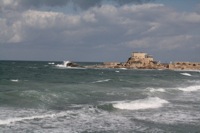 The 2,000-year-old theater still retains its original steps, constructed by Herod. I climbed down into an orchestra pit to see the area under the stage where actors prepared for their appearance.
The 2,000-year-old theater still retains its original steps, constructed by Herod. I climbed down into an orchestra pit to see the area under the stage where actors prepared for their appearance.
At the amphitheater, which once held chariot races in the vein of Ben Hur, I saw more evidence of the wealthy Mediterranean port that Herod created at Caesarea. While looking down the 820-foot-long, U-shaped entertainment structure, it was easy to picture the thundering hooves and careening chariots that once sped around the track.
The park had many excavated archaeological sites open for tours. One of the most important structures lies partially under the turquoise waves of the Mediterranean Sea.
“Welcome to the palace,” said Yehuda Ben Baruch, certified tour guide of Israel. “This is the palace that King Herod built for himself. He liked himself a lot. He was always building palaces for himself.”
The park’s museum features a 10-minute film about Caesarea’s different Roman, Christian and Muslim occupants over the centuries. Artifacts and high-tech holograms of influential figures of Caesarea, such as King Herod and Empress Helena, help in providing a historic context for the park’s ruins.
Afterward, I stopped at the Basilica of the Annunciation in Nazareth, the first of many churches I would see that honor a part of Jesus’ life. It is believed that the Angel Gabriel informed Mary that she would give birth to the Son of God at the basilica site. As in many Christian churches in Israel, different archaeological periods merge within one church, with the original archaeological ruins from the time of Jesus surrounded by fourth-century Byzantine and 12th-century Crusade structures.
The Vatican constructed the 1969 basilica over the cave of Mary’s visitation by the Angel Gabriel and the foundations of the Byzantine and Crusade churches. With the stained-glass windows providing most of the light for the dimly lit lower level, I seemed to walk on bright reds, yellows and blues reflected upon the floor. My attention was drawn up to the 180-foot-high dome, whose shape resembles the Madonna lily.
Straight from the Bible
A drive to the Sea of Galilee region where Jesus spent most of his adult life led to more Christian churches that were built around moments in Jesus’ life. Each church was built on a hill with flowering gardens and scenic views of the Sea of Galilee. Among them are the meditative Mount of Beatitudes, the mosaic-filled Church of the Multiplication of Fishes and Loaves, Mount Tabor’s ornate Church of the Transfiguration and the Octagonal Church in Capernaum, where Jesus began his ministry.
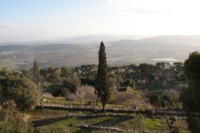 “It used to be a very big city in the time of Christ, with 200 people,” said Baruch about Capernaum’s extensive preserved excavations from the first century. “It’s a huge place for 2,000 years ago. In our time, it’s nothing. People that were very loyal to him and protected him lived here. They were the PR of Christ.”
“It used to be a very big city in the time of Christ, with 200 people,” said Baruch about Capernaum’s extensive preserved excavations from the first century. “It’s a huge place for 2,000 years ago. In our time, it’s nothing. People that were very loyal to him and protected him lived here. They were the PR of Christ.”
The traditional house of Peter, synagogues and amazingly intact homes from the time of Christ all lie open for visitors to explore along the same paths where Jesus and his disciples once walked.
The next day, I wandered through another town uncovered at Qumran, the location where the Essenes lived and wrote the Dead Sea Scrolls. The Qumran Museum prepared me to see the archaeological ruins of the Essenes, a first century Jewish sect whose members wrote the scrolls on animal skins before hiding them in nearby caves.
“If you put this paper in the sun for two years, it would dissolve,” said Baruch. “That’s why they put it in jars in caves to preserve it. Now, in museums, we keep it in the dark and cold to continue to preserve it.”
The archaeological remains of a scribes’ room, ritual bath, cemetery and dining room help paint a picture of the Essenes’ closed-off society devoted to sacred texts. Carved visibly into surrounding cliffs are some of the caves that held the original scrolls for centuries before some Bedouins accidentally found them in 1947 while looking for their sheep.
A child was born
Light beams shone down into the Greek Orthodox Church with bright rays reminiscent of the original star of Bethlehem, pictured so often in Nativities. The Church of the Nativity in Bethlehem maintains an ancient feel with a heavy smell of incense, mosaics from the Crusades and ornate hanging lamps. Reminders of Empress Helen’s third-century cathedral and the Crusaders’ 13th-century construction remain inside the church that celebrates the location of Jesus’ birth.
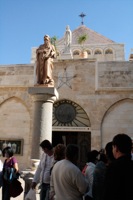 “If you are a Christian, this is the physical location of where God was born,” said Maher Desouki, my tour guide for Bethlehem. “The Church of the Nativity has survived many wars intact, which makes it even more of a treasure.”
“If you are a Christian, this is the physical location of where God was born,” said Maher Desouki, my tour guide for Bethlehem. “The Church of the Nativity has survived many wars intact, which makes it even more of a treasure.”
Below the main church, stairs lead to the cave believed to have sheltered Mary and Joseph when there was no room at the inn. I entered the dark and lavishly decorated Grotto of the Nativity with other pilgrims to the sound of “Oh, Come All Ye Faithful,” sung in Latin by one of the visiting church groups.
Later, I saw a livelier side of Bethlehem at the Bethlehem Market. There, along stone streets, townspeople sell everything from live chickens to carpets. The bustling, friendly atmosphere reminded me that Bethlehem is more than a historic story; it is also a present reality with its own culture.
I sampled a touch of Bethlehem’s Palestinian heritage at the Shepherd’s Valley Village and Tent Restaurant. Under tentlike draped cloths, I shared plates of salads, lamb and chicken with my tour group.
Perched on one of Bethlehem’s hillsides, Shepherds’ Field marks the traditional location of where angels informed the shepherds of Jesus’ birth. A cave where they might have lived has been used as a chapel since the third century. Nearby, the newer 1954 Shepherds’ Church, shaped like a shepherd’s tent, has windows overlooking first-century excavated remains and the sweeping valleys and hills below.
“The church is uniquely built with many windows to show stars coming through, like it would have looked like in the original caves,” said Desouki. “The view from the Shepherds’ Field is amazing. You can see all the way to Jerusalem.”
The City of David
Jesus died not far from his hometown. Jerusalem’s Mount of Olives is a short drive from Bethlehem. The hill offers clear views of Jerusalem’s Old City with the golden Dome of the Rock gleaming beside the cream-colored Jerusalem stone buildings.
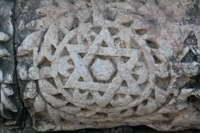 With black-clad Orthodox Jews with side curls walking by, the muezzins singing five times daily as a call to Islamic prayer and tolling church bells echoing across the city, religion remains constantly in focus in Jerusalem. Even when I visited the most beloved Jewish religious site, the Western Wall, the golden Islamic Dome of the Rock was visible above the wall.
With black-clad Orthodox Jews with side curls walking by, the muezzins singing five times daily as a call to Islamic prayer and tolling church bells echoing across the city, religion remains constantly in focus in Jerusalem. Even when I visited the most beloved Jewish religious site, the Western Wall, the golden Islamic Dome of the Rock was visible above the wall.
In the Christian section of Jerusalem along the Via Dolorosa trail, marked stations guide pilgrims who walk the same route Christ followed on his way to crucifixion. The path crosses modern shops and ancient excavations until it ends at the Church of the Holy Sepulcher, where many believe Jesus died.
“Try to imagine [that] when Jesus was here, there was no city,” said Baruch. “It was a field. Now it is inside the city.”
An ancient ambiance pervades the dark, incense-filled Greek Orthodox church. Winding passageways through various chapels eventually led me to the main chapel, where monuments to Jesus’ cross and tomb stand. A somber mood hangs in the air, partially from the ceilings and walls that have been blackened from centuries of candlelight.
Jerusalem B.C.
The history of Jerusalem stretches back to long before Jesus’ arrival, as I learned at the City of David National Park. The archaeological attraction features ruins of a palace from 3,000 B.C., during the time of King David’s reign.
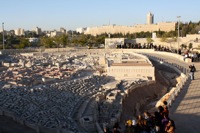 As I was stepping down ancient cistern tunnels running deep into the underbelly of Jerusalem, my guide explained how things like water systems, palace remains and an ancient privy can teach us about the people living in the land once called Judah.
As I was stepping down ancient cistern tunnels running deep into the underbelly of Jerusalem, my guide explained how things like water systems, palace remains and an ancient privy can teach us about the people living in the land once called Judah.
“The Bible doesn’t tell us about daily life,” said Asher Altshul, licensed tour guide for the City of David. “We can now learn that through archaeology. We can see what people were eating. We found that some were eating weeds and things, semipoisonous, because the city was under siege.”
White-stoned ruins and underground spring systems used by kings of the Old Testament gave the guided tour a sense of excitement and importance, as many findings confirmed certain passages in the Bible.
I ended my tour of the Holy Land at a museum that encapsulated my entire experience in one building: the Israel Museum. Inside a dark gray, cylinder-shaped room that looked like the inside of a jar, I examined the sacred Dead Sea Scrolls. Illuminated for visitors with explanations in English, the parchments make up one of the oldest biblical manuscripts, dating from 150 B.C. to A.D. 70.
Outside the 1965 national museum, a 21,520-square-foot scale model of Jerusalem in the late Second Temple period illustrates the layout of the city during Jesus’ time. My guide pointed out several landmarks we had explored during the last few days to give me a sense of what it looked like in the first century.
“This model shows the Western Wall and all the other parts of Jerusalem we’ve been exploring,” said Baruch. “Now we can get an aerial view of what we’ve been exploring to understand where we’ve been.”
Looking over Jerusalem, it struck me as remarkable how much of the city has stayed the same over 2,000 years. No skyscrapers or modern office buildings change the view, which is one reason Jerusalem remains such an icon of history, religious culture and picturesque beauty.
For more Israel attractions and a photo slideshow from Eliza’s trip, check out our Web-exclusive content at www.banktravelmanagement.com.
Israel Ministry of Tourism
888-774-7723
www.goisrael.com
For More Information:
Israel: They call it the “Jesus boat”
WEB EXCLUSIVE: A closer look at the Wailing Wall
WEB EXCLUSIVE: Yad Vasheem, the Holocaust Museum









